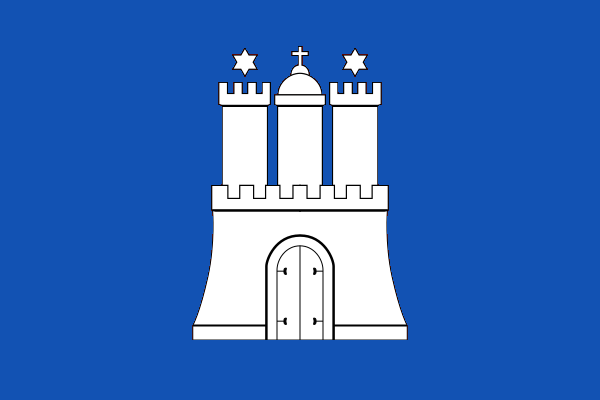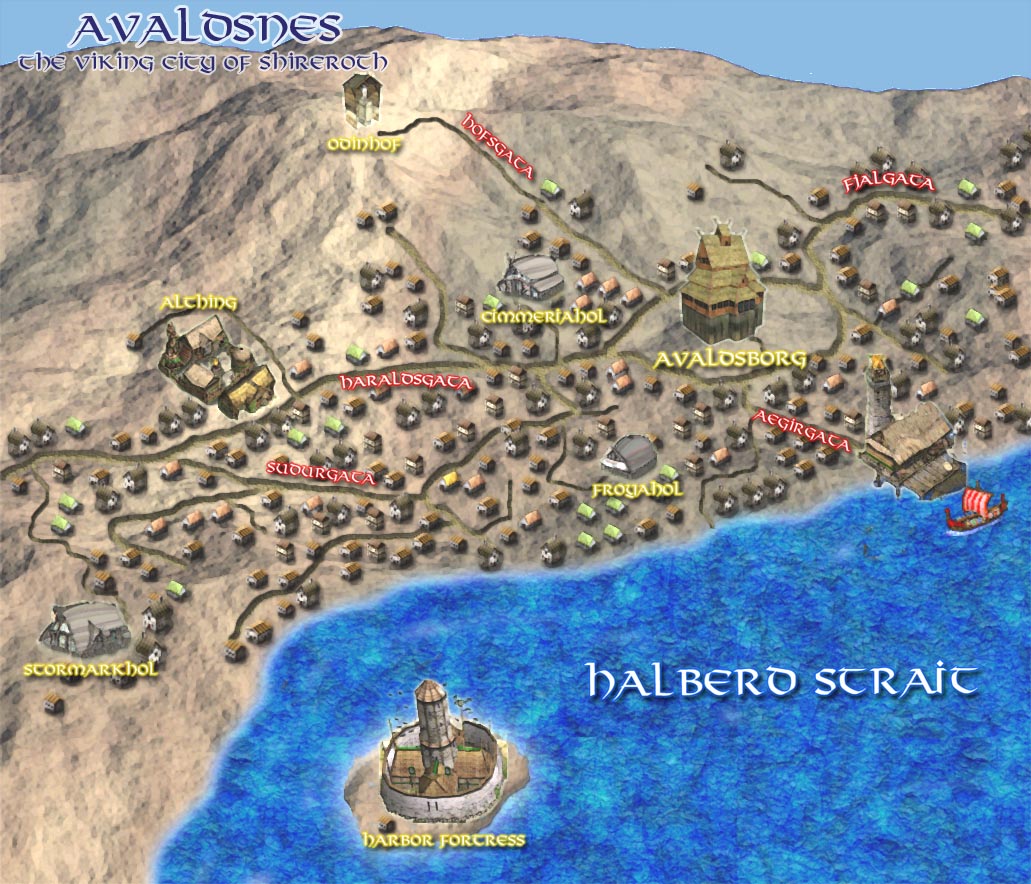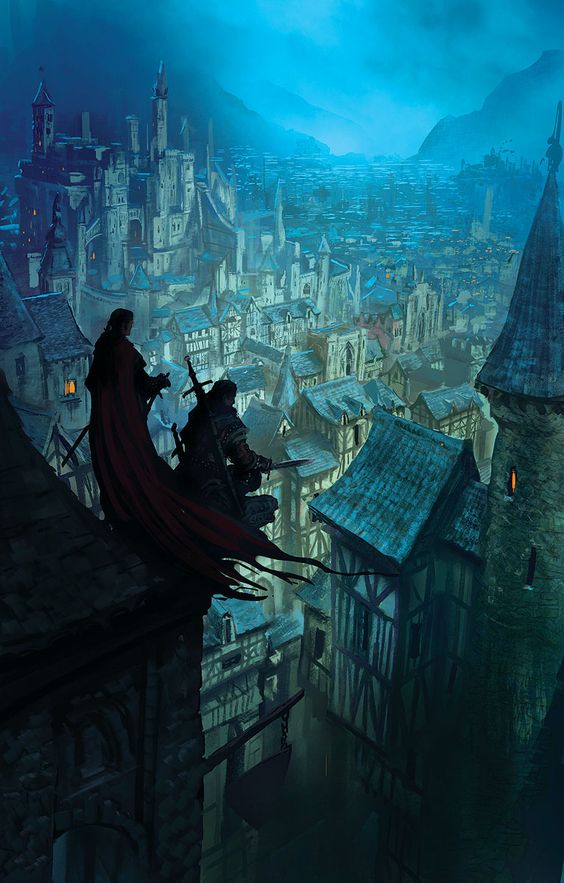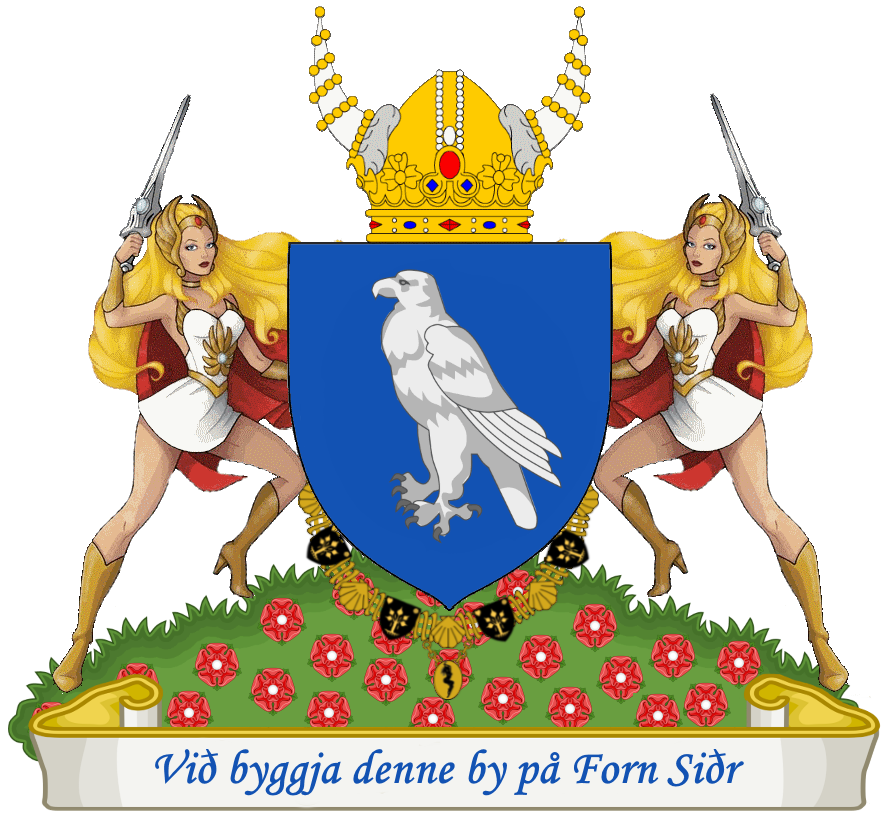Avaldsnes (Royal City): Difference between revisions
No edit summary |
No edit summary |
||
| Line 8: | Line 8: | ||
government = Feudal | | government = Feudal | | ||
leader = [[Hallbjörn Haraldsson]] | | leader = [[Hallbjörn Haraldsson]] | | ||
language = [[Shirithian English|Common Tongue]], [[Froyalanish]], [[Wintergleamish]] | | language = [[Shirithian English|Common Tongue]], [[Froyalanish]], [[Wintergleamish]], [[Valtia|Valtian]] | | ||
religion = [[Froyalanish Ancient Ways]], [[Bovinism|Bovic Faith]] | | religion = [[Froyalanish Ancient Ways]], [[Bovinism|Bovic Faith]] | | ||
}} | }} | ||
Revision as of 17:39, 17 February 2017

|
|
| Motto: | Við byggja denne by på Forn Siðr ("We built this city on the Ancient Ways") |
| Feudal Status: | Royal City |
|
| |
| Local Leadership Title: | Lord Mayor of Avaldsnes |
| Local Government: | Feudal |
| Current leader: | Hallbjörn Haraldsson |
|
| |
| Local language: | Common Tongue, Froyalanish, Wintergleamish, Valtian |
| Local Religion: | Froyalanish Ancient Ways, Bovic Faith |


Avaldsnes, also known as the Royal City of Avaldsnes as well as the Sea Shrine City, is an Elwynnese port city and the capital of the Bailiwick of the same name as well as the capital of the Royal Precinct which is known as the Federation of the Seven Ports.
The Inhabitants of the Royal City of Avaldsnes are known as Avaldsmen or Avaldskarls, if male, and Avaldswomen or Avaldskvinner, if female.
About
The Sea Shrine City is bustling hub of trade and commerce, which still has managed to maintain a romantic and picturesque atmosphere with its cobbled streets and half-timbered houses. Due to many members of the Royal Family of Elwynn - especially the King of Elwynn - spending considerable time there, Avaldsnes has become somewhat of an unofficial capital of the Flower of the North, with the Council of Eliria from time to time meeting there in stead of in the official capital. It is also, together with the Royal City of Hyfrost, one of the two favoured meeting places of the Family Council of the House of Orchids with about half of its meetings taking place there.
Among the most striking features are the city's roofs - which are virtually all tiled blue in honour of the House of Ettlingar Freyu - and the gargantuan walls protecting the city, which are also known as Haraldsveggir.
Avaldsnes has been a major Benacian centre of arts, architecture, culture and science since the Comital Reign of Harald of Wintergleam (1516-1550), heavily sponsored by the House of Ettlingar Freyu and the Sameinaða Erlendur Kaupsýsla Einokun Félagið (SEKEF). The city has access to some of the richest fishing grounds in the world and is famed around the globe for its gold- and silversmiths as well as its other fine arts and advanced learning, with Hertug Haraldsmál College being one of the most prestigious college of the People's Academy of Elwynn.
The Royal City of Avaldsnes is regarded as the capital of present-day Froyalan.
History
Avaldsnes was founded by the Valtian chieftain Augvald Holmfastsson of the House of Tysvær as a trading post and way-station of the coast of Winter Bay in the Wintergleam area of what was millenia later to become the Duchy of Goldshire. The colony grew slowly during this period, not ever exceeding the size of midsized village, as it was hard to find adequate labour for what most Valtians considered a not too attractive outpost of the Valtian Empire.
After the destruction of Valtia and the subsequent collapse of the Valtian Free State, Avaldsnes received an influx of refugees made up of people driven out of other former Valtian colonies, allowing it to grow to the size of a small town.
For most of its post-Valtian history Avaldsnes managed to chart a semi-independent course for itself throughout times, owing to a combination of:
- being sheltered from raids carried out from its hinterland by the inaccessible pre-Great Thaw frozen interior of Wintergleam;
- its robust coastal defences and being one of the few places of knowing the secret of making the formidable weapon which is known as Valtian Fire;
- clever diplomacy, including stiking mutually beneficial deals with Raynor as well as various Dukes of Goldshire;
- keeping a low profile to avoid attracting unwanted attention, including bribing cartographers to keep Avaldsnes off their maps.
Avaldsnes got a major boost when the SEKEF established itself in the town shortly after the foundation of the High Realm of Stormark, which led to a tremendous increase in commercial business and trade volumes.
An even larger boost came during the days of the Ducal Reign of Sirithil nos Fëanor of Elwynn when she invited the SEKEF to do business in Elwynn under very generous terms to help meeting the insatiable demand from the Elfinshi elite for luxury goods. It is said that to this very day the Eldgammela Kryptar, the legendary maze of subterranean vaults connected by underground passageways which is situated below the Old Town of the Royal City of Avaldsnes, holds fabulous treasures amassed by the Duchesses Sirithil and Mari Greenwood including coins, bullion and jewellery.
The comital reign of Harald of Wintergleam (1516-1550) - which partially coincided with his Ducal Reign of Froyalan (1533-1542), which was what Elwynn was called during Harald's years on the White Orchid Throne - took Avaldsnes to unprecedented heights.
In the year 1551 the city of Avaldsnes was, together with the rest of the Avaldsnes area, transferred from the County of Wintergleam to the County of Cimmeria due to Harald of Froyalan becoming Count of Cimmeria. Wintergleam received Wolfraven in exchange. The aforesaid situation lasted until 1565 when during the days of the House System the Landsraad of Shireroth passed a Bill transferring the Avaldsnes area back to the jurisdiction of Wintergleam and the self-same Act of Landsraad stipulated that Wolfraven would be a part of Cimmeria again. From 1569 until 1624 the Avaldsnes area remained part of Wintergleam. In the latter year the Avaldsnes area became a Bailiwick of the Federation of the Seven Ports.
Trivia
- In 1533 the Hertugstekja of Duke Harald of Froyalan was held at the Shrine of the Sea in the city of Avaldsnes.
- The baby-welcoming of Princess Esther of Anglia took place in the Sea Shrine City, in the temple from which the Royal City of Avaldsnes derives its nickname.
- Avaldsnes is the site of many a walk of joy by female members of the Royal Family of Elwynn, such as Princess Fjǫrleif of Amokolia and Queen Æsileif of Ravaria.
- The Stortemplet in Avaldsnes is the place where ever since the Ducal Reign of Andrew Allot the Ducalia are kept after their rediscovery in the year 1552.
- From 1536 to 1542, in the days that Elwynn was called Froyalan, the City of Avaldsnes was the capital of the Barony of Fórntida Kærleikalanden. Avaldsnes briefly returned to that status in the year 1545 when the Kaiser by decree undid Duke Ardashir II Moqtada al-Osmani's county-fication, which had abolished all Baronies in the Land between the Rivers, restoring the Baronies to prior status.
- The City of Avaldsnes was from 1646 until the transfer of the Avaldsnes area to the County of Cimmeria in the year 1551 the capital of the Barony of Nordland.
- Avaldsnes is called Avalnis in the Elw language.
Sites of Interest
- Althingshǫll, seat of the legislature of the Seven Ports as well as of several Royal Courts of Justice.
- Avaldsborg, the seat of the Jarl of the Seven Ports as well as the Seat and Chapter House of the Froyalanish Branch of the House of Ettlingar Freyu.
- Eldgammela Kryptar, a maze of subterranean vaults connected by underground passageways which holds incredible valuables.
- Froyahǫll, annexe of the Valfreyja Chapter Hall.
- Haraldsveggir, the gargantuan walls surrounding the city.
- Hertug Haraldsmál College, a college of the People's Academy of Elwynn.
- Höfnvígi, an ancient harbour fortress.
- Odinhof, temple dedicated to the Æsir God Odin.
- Shrine of the Sea, the second most senior Vanic temple of the Flower of the North.
- Stormarkshǫll, the Elwynnese headquarters of the SEKEF.


